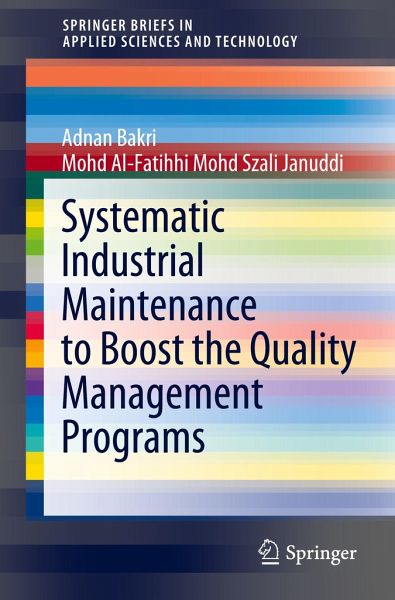
Systematic Industrial Maintenance to Boost the Quality Management Programs

PAYBACK Punkte
19 °P sammeln!
This book discusses the main quality management (QM) programs and their possible integration into systematic industrial maintenance (SIM). Unlike traditional engineering maintenance books, it not only explains the theory but also provides practical examples of the integration of QM and SIM programs. It also includes reference sources, making it useful for readers wanting to explore specific areas in more depth.Chapter 1 introduces various aspects of the main quality management (QM) programs, including total quality management (TQM), just-in-time (JIT) and lean manufacturing (Lean). Subsequentl...
This book discusses the main quality management (QM) programs and their possible integration into systematic industrial maintenance (SIM). Unlike traditional engineering maintenance books, it not only explains the theory but also provides practical examples of the integration of QM and SIM programs. It also includes reference sources, making it useful for readers wanting to explore specific areas in more depth.
Chapter 1 introduces various aspects of the main quality management (QM) programs, including total quality management (TQM), just-in-time (JIT) and lean manufacturing (Lean). Subsequently, it examines the relation of quality and maintenance. Chapter 2 reviews the concepts of systematic industrial maintenance (SIM) and the application of quality control (QC) tools. Chapter 3 offers an overview, historical perspective and trends in industrial maintenance techniques. Chapters 4, 5, 6, 7, 8 and 9 focus on topics related to schedule-based maintenance, condition-based maintenance, reliability-based maintenance, computerized-based maintenance, risk-based maintenance and total productive maintenance. Covering the theory of each of these types of SIM, the chapters also explain their real-world application in QM and highlight their merits and weaknesses in the context of supporting QM.
Chapter 1 introduces various aspects of the main quality management (QM) programs, including total quality management (TQM), just-in-time (JIT) and lean manufacturing (Lean). Subsequently, it examines the relation of quality and maintenance. Chapter 2 reviews the concepts of systematic industrial maintenance (SIM) and the application of quality control (QC) tools. Chapter 3 offers an overview, historical perspective and trends in industrial maintenance techniques. Chapters 4, 5, 6, 7, 8 and 9 focus on topics related to schedule-based maintenance, condition-based maintenance, reliability-based maintenance, computerized-based maintenance, risk-based maintenance and total productive maintenance. Covering the theory of each of these types of SIM, the chapters also explain their real-world application in QM and highlight their merits and weaknesses in the context of supporting QM.














